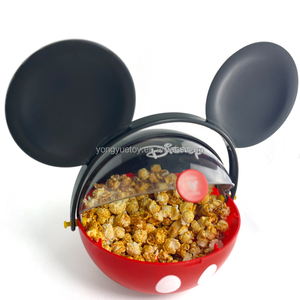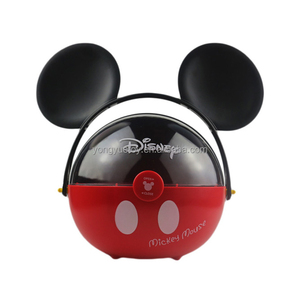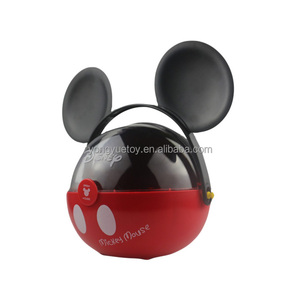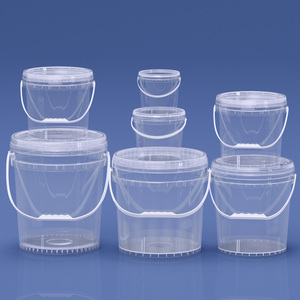
All categories
Featured selections
Trade Assurance
Buyer Central
Help Center
Get the app
Become a supplier

(2835 products available)








































Water plastic bucket mould employs different materials to ensure durability, shape, and adaptability. Here’s a list of the most common bucket mould materials:
Steel Alloys
Both medium and high-quality steel materials are used to make water plastic bucket moulds. In plastics, stainless steel is used to make moulds where the plastic will stick or corrode, such as polyethylene. Stainless steel is also easy to polish and highly resistant to chemical exposure.
Aluminium
Aluminium is lightweight and offers superior heat transfer, making it an ideal material for plastic bucket mould. Due to this property, aluminium moulds are suited for producing buckets where quick cycle times are preferred. Although aluminium is softer than steel, the addition of alloys like copper and silicon increases hardness and longevity.
Brass
Brass, a highly resistant metal against corrosion, is commonly used in water environments where stability and longevity are the key factors. The plastic lumps easily release on brass moulds due to the metal's low friction surface. Brass is also resistant to acids and bases and thus ideal for producing plastic buckets intended for storing chemicals or cleaning agents.
Titanium Alloys
Titanium ranks low in availability but highly resistant to corrosion compared to easily available metals. It’s also strong and lightweight. Titanium moulds suit long-term production of plastic buckets required in highly demanding environments, be it thermal stress or chemical exposure.
Copper Alloys
Copper, although primarily used as an alloy with other metals, offers excellent thermal conductivity properties. Buckets made of copper alloys provide better heat transfer than aluminium, thus ideal for thermal regulation during plastic moulding. It’s also resistant to corrosion, giving it proper application in environments exposed to water or chemicals.
Plastic moulds are common in many industries that require producing plastic buckets in large quantities with high precision. Below are the common uses of plastic bucket moulds:
Household Cleaning Products
Plastic buckets usually produced through plastic bucket manufacturing are extensively used in household cleaning products. Cleaning solutions, mops, and sponges need durable and water-resistant buckets. In this space, moulds create different designs of cleaning buckets with features like wringing systems or multiple compartments for holding cleaning liquids and tools.
Construction and Painting
Plastic buckets are used to store paint, sealants, and adhesives in construction and painting industries. Moulding plastics produce pain buckets with features such as textured grips or lids. Therefore, this will help in the retention of material, moisture, and spillage minimisation during transportation.
Outdoor and Gardening
Buckets are handy tools in gardening and outdoor activities. They help transport soil, water, and tools. Moulds create sturdy buckets that can withstand outdoor activities and adverse weather. These buckets may also come with holes for draining water or special liners for carrying plants and seeds.
Industrial Applications
In industries, plastic buckets hold hazardous materials, chemicals, or waste. Due to this variance in application, moulds produce heavy-duty buckets resistant to such chemicals. Mould designs also ensure that buckets have lids and contain spills to promote safety and compliance.
Food Storage and Transport
In food processing and agriculture, plastic buckets are widely used to store and transport food items. Water plastic bucket moulds produce food-grade buckets manufactured with safety materials to prevent contamination. These molds design buckets with sealed lids for safe food storage and transport.
DIY and Hobby Products
Buckets have multiple uses in crafting, painting, or even home improvement projects. Plastic bucket molds create different sizes and shapes of buckets tailored to specific projects. For example, smaller buckets may be used in arts and crafts, whereas larger ones suit home renovation projects.
Water plastic bucket moulds have various customization options to meet diverse needs. Below are the common customization options for water plastic bucket moulds:
Material Selection
Bucket mould materials vary in terms of property and usage. For example, aluminium alloys are suitable for fast-production moulds, while stainless steel works on durability and corrosion resistance. Brass moulds reduce friction and are ideal for materials that require high release properties. Copper alloys that have high thermal conductivity are suitable for moulds that require efficient heat transfer.
Design Customizations
Customisation options allow users to create moulds with specific shapes, sizes, textures, and embossed designs. Advanced technology makes it easy to design even the most complex patterns. Adding functional features like measurement markings, handles, or pour spouts is possible. It’s also easier to manufacture buckets that are either round, square, or other polygon shapes.
Cavitation Number
Cavitation number determines the number of identical buckets produced in one cycle. High cavitation moulds produce more buckets at once, whereas low cavitation is suitable for custom buckets with unique features. Adjusting this number optimally meets the desired production rate and manages costs effectively.
Surface Finish Options
Moulds come with different surface finish options that highly affect the final bucket texture and functionality. Among smooth finishes that ensure easy plastic bucket release are textured finishes that may provide better grip or aesthetic function. Surface finishes also affect plastic adhesion and moulds can be customised to suit specific requirements.
Cooling System Design
Cooling systems help improve the efficiency and quality of the final product. Fast cooling reduces cycle time, while slow cooling provides better quality through even cooling. Users customise cooling systems based on their production speed and bucket usage.
Plastic moulds for buckets are crucial in determining the bucket's quality, durability, and efficiency in producing the mould. Below are the important factors to consider when choosing water plastic bucket moulds:
Material Quality
Plastic moulds come with high-quality steel, aluminium, and brass. Among those that offer durability and prolonged bucket plastic are aluminium moulds that provide superior heat transfer, hence optimum cooling. There’s also stainless steel, which is highly resistant to corrosion and chemicals and ideal for producing buckets with high volume.
Mould Design
Consider the required design complexity. If the bucket has simple shapes, it’s easier to create moulds. Complex designs may require advanced technology. Also, consider the size of the mould. Large buckets may need bigger moulds, while small ones are manageable.
Cooling System
The cooling system affects the cycle time and efficiency of plastic bucket making. Advanced cooling systems ensure even cooling, minimise warping, and reduce cycle time. Choose a mould with an effective cooling system to guarantee better plastic bucket quality.
Compatibility with Injection Moulding Machine
Ensure the mould is compatible with the existing injection moulding machine. Moulds come with different sizes and designs. Always consider the machine size and the required injection pressure for the mould. Compatibility avoids complications bottling the machine and ensure efficient production.
Durability and Maintenance
Consider the durability of the mould material. Durable materials withstand wear and tear, which ensures long-term production without defects. Choose moulds requiring minimum maintenance. They reduce the mould's downtime and operating costs, hence ideal for high-volume production.
Manufacturer's Reputation
Choose a renowned manufacturer with practical experience in producing bucket molds. Such manufacturers provide quality products and after-sale services. Check customer reviews to understand the product's quality and performance.
A. Polypropylene ranks high when it comes to bucket plastics. It’s impact-resistant, lightweight, and possesses exceptional chemical resistance. Because of these properties, Polypropylene makes buckets suitable for various applications, ranging from cleaning to carrying, to storage. Additionally, this plastic comes in a wide range of temperatures, hence suitable for various environments.
A. Yes, injection-moulded buckets rank high in durability. The process of injection moulding gives these buckets robust and seamless designs, which reduce their tendency to crack or wear under stress. In addition, the plastics used, ranging from Polypropylene to polyethylene, exhibit resistance to UV rays, chemicals, and other environmental factors.
Urban maintenance involves using chemicals that are compatible with the material used in tbucket's cleaningand routinely checking for any visible wear.The cooling system should also be examined and cleaned to ensure effective cooling during mould operation. Additionally, applying release agents and ensuring proper lubrication on the mould parts reduces friction and aids in easier bucket mould release.
Moulds are designed to create stronger plastic buckets through even material distribution and wall thickness maximisation. Advanced moulds incorporate pressure and temperature control. Such practices enable crystallization and enhance strength. Complex designs also add ribbing or reinforcement areas that increase sturdiness and help resist deformity during heavy use.
Key characteristics of plastic bucket moulds include precision, durability, and thermal conductivity. Plastics easily release requires moulds with a finely polished surface and high precision. Robust materials, such as stainless steel or aluminium, construct moulds to withstand repeated production. The moulds’ thermal conductivity ensures even plasticisation and prevents hotspots.